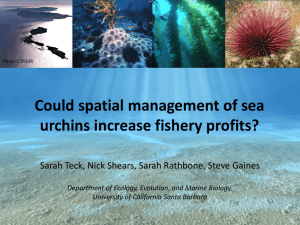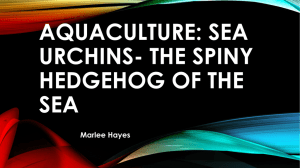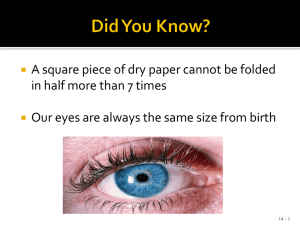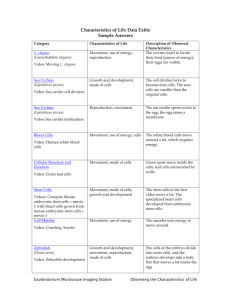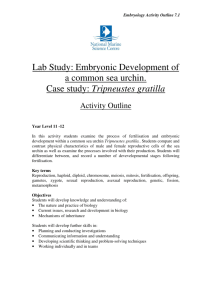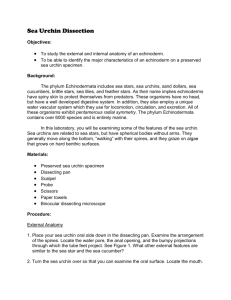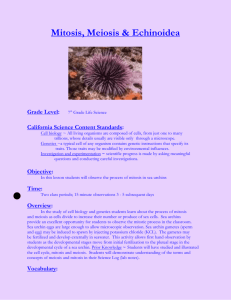ITRS_TECK_Sarah
advertisement
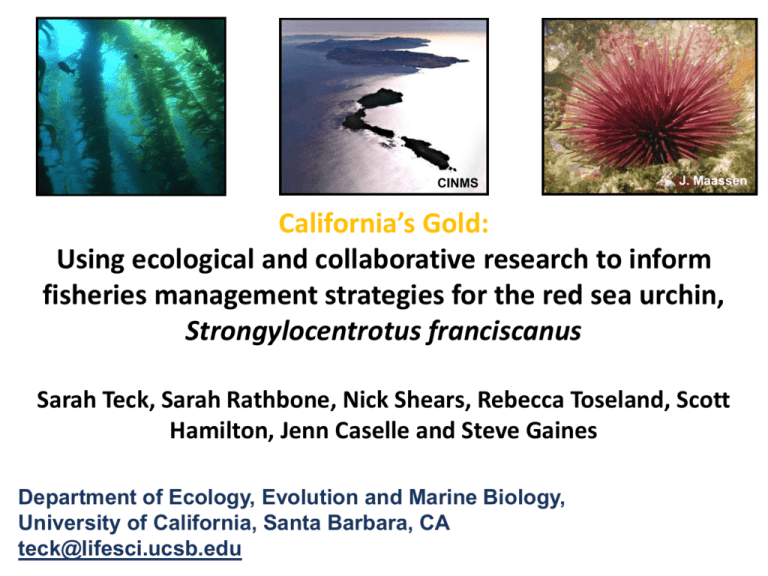
CINMS
J. Maassen
California’s Gold:
Using ecological and collaborative research to inform
fisheries management strategies for the red sea urchin,
Strongylocentrotus franciscanus
Sarah Teck, Sarah Rathbone, Nick Shears, Rebecca Toseland, Scott
Hamilton, Jenn Caselle and Steve Gaines
Department of Ecology, Evolution and Marine Biology,
University of California, Santa Barbara, CA
teck@lifesci.ucsb.edu
California’s Gold
incabrain.com
San Francisco
~34°N
~120°W
Santa Barbara
Santa Barbara
San Miguel
Santa Rosa Santa Cruz
Anacapa
25 km
California’s Gold
(5th largest fishery)
incabrain.com
~52% is landed
here
Santa Barbara
San Miguel
~66% is harvested
from here
Santa Rosa Santa Cruz
Anacapa
25 km
Sea Urchin Fishery in California
60
millions of lbs and $
50
40
30
20
10
0
1970
1975
1980
1985
1990
1995
2000
2005
Data: CDF&G
Sea Urchin Fishery in California
60
millions of lbs and $
50
40
30
20
10
0
1970
1975
1980
1985
1990
1995
2000
2005
Data: CDF&G
60
1600
1400
50
millions of lbs and $
40
1000
30
800
CPUE (lbs/receipt)
1200
600
20
400
10
200
0
0
1970
1975
1980
1985
1990
1995
2000
2005
Data: CDF&G
89 mm N CA;
76 min
size limit seasonal limit #
days per week
Moratorium
83 mm S CA;
on permits
seasonal limit #
days per week
60
50
1600
1400
millions of lbs and $
↓ Japanese
economy
40
30
1000
800
El Niño
El Niño
20
↑ market
competition
CPUE (lbs/receipt)
1200
El Niño
600
400
10
200
0
0
1970
1975
1980
1985
1990
1995
2000
2005
Data: CDF&G
89 mm N CA;
76 min
size limit seasonal limit #
days per week
Moratorium
83 mm S CA;
on permits
seasonal limit #
days per week
60
50
1600
1400
millions of lbs and $
↓ Japanese
economy
40
30
1000
800
El Niño
El Niño
20
↑ market
competition
CPUE (lbs/receipt)
1200
El Niño
600
400
10
200
0
0
1970
1975
1980
1985
1990
1995
2000
2005
Data: CDF&G
Motivation
• Status of the stock
unknown
• Collect baseline
information —
precautionary approach
• Integrate ecological, economic, and fisheries
data to improve management
• Can yields or profits increase with different
management?
Quality, not just quantity and size
fished species:
o population size
o individual size
urchins:
o gonad quality
• time (seasons)
• space (islands)
Objective: temporal and
spatial variability of gonad
quality fisheries
management
Steep temperature gradient
(Blanchette et al 2007)
b)
Purple urchin abundance 2007
Steep biotic gradient
34.2
S. purpuratus
34
2007 purple abundance
Macrocystis
pyrifera
COMPETITOR
33.8
Figure
Spatial distribution
urchin landings
from
-119.2
-119.4
-119.8of red-119.6
-120
-120.2
-120.4 4. (a)
-120
-120.2
-120.4
1985 to 2005 in the CINMS (landings are assigned to 10 x 10
nautical mile blocks as reported to CA Dept. of Fish and
Game), and (b) spatial variation in purple urchin abundance
(the larger the circle the greater the density; Data:
PISCO/SBC-LTER)
RESOURCE
by Scott Gietler
• Sites deforested by purple
urchins ~33-87% of the time
(Shears in prep, National Park
Service-Kelp Forest Monitoring
data 1985-2007)
Port sampling
>400 boats surveyed
Dec 2008-present
location, effort, landings,
GSI, price…
Objective: temporal and
spatial variability of gonad
quality fisheries
management
Gonad quality (size, texture and color)
$1.10
$1.00
$ per lb
paid to
fishermen
$0.90
$0.80
$0.70
$0.60
6%
P=0.0045
R2=0.71
8%
10%
12%
14%
16%
% gonad of whole body weight or
GONADOSOMATIC INDEX (GSI)
18%
20%
Gonadosomatic Index
Gonad quality is highly variable
0.22
0.2
0.18
0.16
0.14
0.12
0.1
0.08
0.06
0.04
0.02
Nov-08
boats=196
urchins=2190
Apr-09
Oct-09
Apr-10
Oct-10
Apr-11
Gonad quality is predicable
mean GSI/month
no diff. AMONG ISLANDS:
(1) mean (2) phase shift (3) period
Amplitude of SCI differs
P=0.0250 *
P=0.0016 **
Why does amplitude vary spatially?
• Gonad quality is governed by physiological
response to environment and ecology
– Temperature
• higher metabolism in warmer water
faster somatic growth?
– Food quality and availability
• less kelp in warmer water and with
competitors (purples)
less allocation to reproduction?
Fishery implications
• Optimal profits to harvest
– SMI/SRI before reproduce (high productivity here)
– SCI after reproduce (lower productivity here)
Next steps…
• Examine fishermen behavior—are they fishing
optimally? (landing receipt data)
• Bioeconomic model—How will urchin
populations and fishery profits respond to
various management regimes?
– ex: Seasonal quota (TAC) or effort ; property
rights (TURFs)
– Optimal harvest strategy over time and space
– Feasible harvest strategy within this fishery
THANKS TO…
• Commercial Fishermen of Santa Barbara: urchin divers, H. Liquornik, S. Mutz
•
Lab assistants: M. Adams, A. Alger, G. Alongi, K. Asanion, M. Bogeberg, E.
Casas, D. Cooper, M. Hunt, S. Meinhold, W. Meinhold, A. Poppenwimer, J.
Roh, R. Shen, T. Shultz, A. Stroud, K. Treiberg, O. Turnross, A. Wong,
•
PISCO dive team: K. Davis, A. Parsons-Field, E. Nickisch, J. Benson, P.
Carlson, L. Hesla, E. Hessell, C. Lantz, JA Macfarlan, C. Pierre, D. Salazar,
B. Selden, A. Soccodato, N. Spindel, S. Windell,
•
EEMB/Bren: Gaines lab, Lenihan lab
•
J. Lorda, L. Pecquerie, H. Salgado, B. Broitman
Extra slides….
Management challenge
gonad
quality
time
peak quality
trough quality
Harvesting in different areas
Reef 1
gonad
quality
Reef 2
time
Harvesting peaks in different areas
Reef 1
Reef 2
gonad
quality
time
Percent gonad is higher in the west
a
9.5%
a
9.5%
32 sites summer 2009
27 sites summer 2010
Santa Barbara
c
b
6.7%
5.6%
San Miguel
Santa Rosa
Santa Cruz
Anacapa
Temperature anomalies
b)
Purple
urchin abundance 2007
Purple urchin abundance 2007
34.2
34
33.8
-120.6
-120.6
Figure
Spatial distribution
urchin landings
from
-119.2
-119.4
-119.8of red-119.6
-120
-120.2
-120.4 4. (a)
-120
-120.2
-120.4
1985
in the
CINMSlandings
(landings are
assigned to 10 x 10
a) to 2005
Red
urchin
1985-2005
Red urchin
landings 1985-2005
nautical mile blocks as reported to CA Dept. of Fish and
Game), and (b) spatial variation in purple urchin abundance
% Landings
(the larger the circle the greater the density; Data:
<1
34.6
PISCO/SBC-LTER)
1-5
Purple urchin abundance 2007
6-10
11-20
20-30
34.4
b) Shears
Purple
urchin NPS—KFM,
abundance 2007CDFG data
in prep,
Partnership for Interdisciplinary Studies of Coastal Oceans (PISCO)
ecosystem research and monitoring (fish and benthic subtidal sampling)
32 sites summer 2009
27 sites summer 2010
Santa Barbara
San Miguel
Santa Rosa Santa Cruz
Anacapa
III. Ecology
Regression model to predict GSI
• Temperature, abiotic factors
• Reserve versus fished
• Community data
What drives variability in
red urchin populations
over time and space?
Port sampling fished sites
19 1
85 9 85
0
20 20
07 07
20
07
20
05
20
03
0
Red urchin biomass
2000
6
1500
5
4
10003
500
2
1
Shears in prep, NPS—KFM data
20
07
20
05
20
03
20
01
10
19
99
2000
19
97
20
07
20
05
20
03
20
01
Fished (n=5)
19
95
19
93
19
91
19
89
19
87
19
99
kelp Kelp
20 20
05 05
Redurchins
urchins
red
20
01
purple urchins
urchins
Purple
19
97
14
20 20
03 03
Fished(n=5)
(n=5)
Fished
20 20
01 01
Reserve(n=2)
(n=2)
Reserve
19
99
0
19 19
99 99
10
19
85
30
19
97
60
19 1
97 9 9
7
Reserve (n=2)
19
95
Fished (n=5)
19
95
Reserve (n=2)
19 19
95 95
0
Density (m-2)
2
19
93
19
91
4
19
93
19
91
19
89
19
87
19
85
6
19 1
93 9 9
3
7
19
89
70
19 1
91 9 9
1
25008
19
87
19
85
-2
Density (m )
Density (m-2)
12
19 1
89 9 8
9
Density (m )
Density (m-2)
Density (m-2)
80
19 19
87 87
-2
-2
Density (m-2)
(gm-2)
Biomass
Biomass (g m )
2500
Reserve (n=2)
Long-term (1985-2007)
E Santa Cruz and Anacapa
8
1500
1000
Fished (n=5)
500
50
40
20
0
19 1
85 9 85
0
20 20
07 07
20
07
20
05
20
03
0
Red urchin biomass
2000
6
1500
5
4
10003
500
2
1
Shears in prep, NPS—KFM data
20
07
20
05
20
03
20
01
10
19
99
2000
19
97
20
07
20
05
20
03
20
01
Fished (n=5)
19
95
19
93
19
91
19
89
19
87
19
99
kelp Kelp
20 20
05 05
Redurchins
urchins
red
20
01
purple urchins
urchins
Purple
19
97
14
20 20
03 03
Fished(n=5)
(n=5)
Fished
20 20
01 01
Reserve(n=2)
(n=2)
Reserve
19
99
0
19 19
99 99
10
19
85
30
19
97
60
19 1
97 9 9
7
Reserve (n=2)
19
95
Fished (n=5)
19
95
Reserve (n=2)
19 19
95 95
0
Density (m-2)
2
19
93
19
91
4
19
93
19
91
19
89
19
87
19
85
6
19 1
93 9 9
3
7
19
89
70
19 1
91 9 9
1
25008
19
87
19
85
-2
Density (m )
Density (m-2)
12
19 1
89 9 8
9
Density (m )
Density (m-2)
Density (m-2)
80
19 19
87 87
-2
-2
Density (m-2)
(gm-2)
Biomass
Biomass (g m )
2500
Reserve (n=2)
Long-term (1985-2007)
E Santa Cruz and Anacapa
8
1500
1000
Fished (n=5)
500
50
40
20
0
2500
Reserve (n=2)
14
Reserve (n=2)
Density (m-2)
12
Long-term (1985-2007)
E Santa Cruz and Anacapa
Fished (n=5)
kelp Kelp
Fished (n=5)
2000
-2
Density (m )
10
Reserve (n=2)
Density (m-2)
70
Density (m-2)
20
07
20
05
500
60
50
40
30
0
Reserve(n=2)
(n=2)
Reserve
7
Fished(n=5)
(n=5)
Fished
20
07
2000
5
1500
4
10003
2
1
20 20
07 07
20 20
05 05
20 20
03 03
20 20
01 01
19 19
99 99
19 1
97 9 9
7
19 19
95 95
19 1
93 9 9
3
19 1
91 9 9
1
19 1
89 9 8
9
19 19
87 87
0
0
20
07
20
05
20
03
20
01
19
99
19
97
19
95
• Reproductive output is ~4
times higher in kelp
forests versus urchin
barrens
500
19 1
85 9 85
Density (m-2)
-2
Density (m )
6
19
93
19
91
19
89
20
05
Redurchins
urchins
red
20
03
20
01
19
99
19
97
19
95
19
91
19
89
19
93
Red urchin biomass
19
87
19
85
25008
19
87
19
85
20
0
-2
20
03
purple urchins
urchins
Purple
Fished (n=5)
10
(gm-2)
Biomass
Biomass (g m )
• Red urchins have
persistently higher
biomass inside of the
reserves.
1000
20
01
19
91
19
89
80
19
87
19
85
0
19
99
2
19
97
4
1500
19
95
6
19
93
Density (m-2)
8
Shears in prep, NPS—KFM data
• manipulate ecology of a
managed area to
increase profits
• Purple urchin removals
in historical red urchin
fishing grounds?
kelp restoration
New strategy for fishing sea urchins
• To take advantage of the high
quality roe at the time when
and locations where it is
available, fish more in winter
and in places where roe is of
the highest quality.
to increase profits to
urchin fishermen
to benefit sea urchin
populations
GSI increases during regrowth
0.20
gonad:somatic index
0.18
0.16
0.14
0.12
0.10
0.08
0.06
0.04
Oct-08
west
central
east
Feb-09
May-09
Aug-09
spawning
Dec-09
Mar-10
Jun-10
Sep-10
gonadal regrowth
IV. Management
How do urchins and fishery
profits respond to various
management regimes?
Assess management strategies
•
•
•
•
•
•
•
•
Seasonal quota (TAC)
Individual quotas
Minimum size limits
Maximum size limits
Limited entry
Area closures
TURFs
Combination of various strategies
Quality varies seasonally
% gonad
of whole
body
weight
20%
14%=$0.92/lb$1468/1600lb load
12%=$0.86/lb$1369/1600lb load
18%
$100 difference * 80 loads/year
16%
$4000/ 6 mo increase
14%
{
12%
~$10,000/yr increase
10%
}
8%
6%
west
4%
Oct-08
Feb-09
May-09
80 loads/year
$6000/ 6 mo increase
Aug-09
Dec-09
Mar-10
central
east
month-year
Jun-10
Sep-10
Reserves may affect gonad quality
(Behrens & Lafferty 2004,
Lafferty & Behrens 2005)
